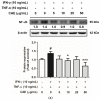Coffea arabica Extract Attenuates Atopic Dermatitis-like Skin Lesions by Regulating NLRP3 Inflammasome Expression and Skin Barrier Functions
- PMID: 37569742
- PMCID: PMC10418848
- DOI: 10.3390/ijms241512367
Coffea arabica Extract Attenuates Atopic Dermatitis-like Skin Lesions by Regulating NLRP3 Inflammasome Expression and Skin Barrier Functions
Abstract
Atopic dermatitis (AD) is a common skin disease worldwide. The major causes of AD are skin barrier defects, immune dysfunction, and oxidative stress. In this study, we investigated the anti-oxidation and anti-inflammation effects of Coffea arabica extract (CAE) and its regulation of the skin barrier and immune functions in AD. In vitro experiments revealed that CAE decreased the reactive oxygen species levels and inhibited the translocation of nuclear factor-κB (NF-κB), further reducing the secretion of interleukin (IL)-1β and IL-6 induced by interferon-γ (IFN-γ)/tumor necrosis factor-α (TNF-α). Moreover, CAE decreased IFN-γ/TNF-α-induced NLR family pyrin domain-containing 3 (NLRP3), caspase-1, high-mobility group box 1 (HMGB1), and receptor for advanced glycation end products (RAGE) expression levels. It also restored the protein levels of skin barrier function-related markers including filaggrin and claudin-1. In vivo experiments revealed that CAE not only reduced the redness of the backs of mice caused by 2,4-dinitrochlorobenzene (DNCB) but also reduced the levels of pro-inflammatory factors in their skin. CAE also reduced transepidermal water loss (TEWL) and immune cell infiltration in DNCB-treated mice. Overall, CAE exerted anti-oxidation and anti-inflammation effects and ameliorated skin barrier dysfunction, suggesting its potential as an active ingredient for AD treatment.
Keywords: Coffea arabica; anti-inflammation; anti-oxidation; atopic dermatitis; immune; inflammasome; skin barrier function.
Conflict of interest statement
The authors declare no conflict of interest.
Figures


















Similar articles
-
The Anti-Atopic Dermatitis Effects of Mentha arvensis Essential Oil Are Involved in the Inhibition of the NLRP3 Inflammasome in DNCB-Challenged Atopic Dermatitis BALB/c Mice.Int J Mol Sci. 2023 Apr 23;24(9):7720. doi: 10.3390/ijms24097720. Int J Mol Sci. 2023. PMID: 37175425 Free PMC article.
-
Ursolic acid ameliorates DNCB-induced atopic dermatitis-like symptoms in mice by regulating TLR4/NF-κB and Nrf2/HO-1 signaling pathways.Int Immunopharmacol. 2023 May;118:110079. doi: 10.1016/j.intimp.2023.110079. Epub 2023 Mar 29. Int Immunopharmacol. 2023. PMID: 36996741
-
Esculentoside A ameliorates DNCB-induced atopic dermatitis by suppressing the ROS-NLRP3 axis via activating the Nrf2 pathway.Clin Exp Pharmacol Physiol. 2023 Nov;50(11):844-854. doi: 10.1111/1440-1681.13809. Epub 2023 Jul 13. Clin Exp Pharmacol Physiol. 2023. PMID: 37439364
-
Preventing NLRP3 inflammasome activation: Therapeutic atrategy and challenges in atopic dermatitis.Int Immunopharmacol. 2025 Jan 10;144:113696. doi: 10.1016/j.intimp.2024.113696. Epub 2024 Nov 27. Int Immunopharmacol. 2025. PMID: 39608174 Review.
-
Oxidative Stress and Atopic Dermatitis.Antioxidants (Basel). 2020 Feb 26;9(3):196. doi: 10.3390/antiox9030196. Antioxidants (Basel). 2020. PMID: 32111015 Free PMC article. Review.
Cited by
-
Suppressive Effect of Coffee Leaves on Lipid Digestion and Absorption In Vitro.Foods. 2024 Aug 2;13(15):2445. doi: 10.3390/foods13152445. Foods. 2024. PMID: 39123636 Free PMC article.
-
Pathogenesis of Inflammation in Skin Disease: From Molecular Mechanisms to Pathology.Int J Mol Sci. 2024 Sep 21;25(18):10152. doi: 10.3390/ijms251810152. Int J Mol Sci. 2024. PMID: 39337637 Free PMC article. Review.
-
Involvement of role of HMGB1-NLRP3 pathway in systemic disorders.Front Cell Dev Biol. 2025 Jul 4;13:1600596. doi: 10.3389/fcell.2025.1600596. eCollection 2025. Front Cell Dev Biol. 2025. PMID: 40688353 Free PMC article. Review.
-
Effect of Chloroquine on Type 2 Inflammatory Response in MC903-Induced Atopic Dermatitis Mice.Clin Cosmet Investig Dermatol. 2024 May 14;17:1093-1105. doi: 10.2147/CCID.S440308. eCollection 2024. Clin Cosmet Investig Dermatol. 2024. PMID: 38765196 Free PMC article.
-
The RAGE Pathway in Skin Pathology Development: A Comprehensive Review of Its Role and Therapeutic Potential.Int J Mol Sci. 2024 Dec 18;25(24):13570. doi: 10.3390/ijms252413570. Int J Mol Sci. 2024. PMID: 39769332 Free PMC article. Review.
References
-
- Nguyen M., Pona A., Kolli S.S., Feldman S.R., Strowd L.C. Recent insights in atopic dermatitis pathogenesis, treatment, and disease impact. J. Dermatol. Dermatol. Surg. 2019;23:66–72.
MeSH terms
Substances
Grants and funding
LinkOut - more resources
Full Text Sources

